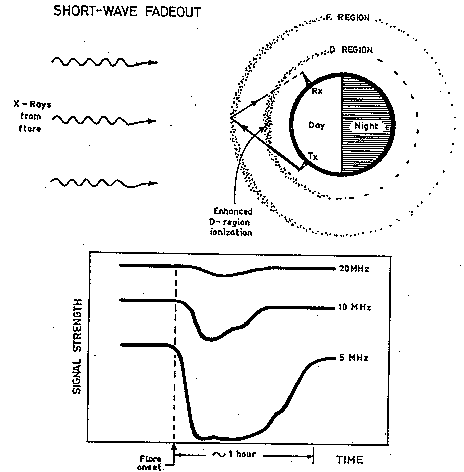Radio Fadeouts and Solar Flares
Solar flares produce copious amounts of electromagnetic radiation, the X-ray component of which increases the ionisation of the ionospheric D layer. HF communication generally depends on the reflection of signals from the higher F layer and such signals must travel through the D layer at least twice. Increased ionisation results in greater absorption of the signal in the D layer.
This effect is known as a short-wave fadeout (SWF) or sudden ionospheric disturbance (SID) and is observed as an increased attenuation of HF signals particularly at the lower frequencies. The fadeout follows closely the pattern of the solar flare, being observed at the same time as the flare. Fadeouts mostly have a rapid onset of a few minutes and a slower recovery lasting perhaps an hour (this is highly variable).
A property of SWFs is that they affect the lower HF frequencies more than the higher ones which may not be affected at all. The high frequencies are the last to be affected and the first to recover.
An important feature of SWFs is that the HF circuit is affected only if there is an ionospheric reflection point for the signal in the sunlit hemisphere. No effect is observed if all the reflection points are located in the night hemisphere which is shadowed from the X-rays from the flare.
The intensity of flares at X-ray wavelengths allows us to estimate the extent (both geographical and in frequency) of a fadeout. This intensity is now measured by satellite and ASWFC has established a page on the Internet to show the extent and location of fadeouts in near real-time.

Material prepared by Richard Thompson





